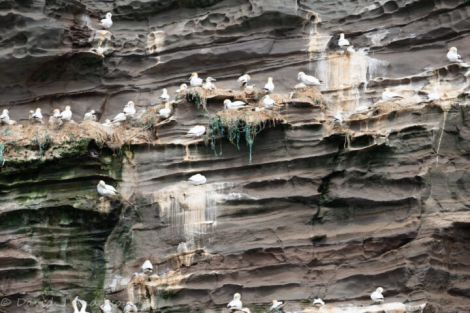Nature / Plastic is built into nearly all North Atlantic gannet colonies
A STUDY has highlighted the threat marine plastic poses to the North Atlantic’s largest seabird.
Researchers studying northern gannet populations across the UK, Norway, Iceland, Canada, the Faroe Islands and Ireland found that birds in 28 out of 29 colonies had incorporated plastic into their nests.
Scientists at the University of the Highlands and Islands, the Natural History Museum and the University of Tasmania used digital photography, visual observation and existing publications to gather data.
A total of 7,280 nests were examined, with 46 per cent found to contain debris. The majority of the debris was threadlike plastics, thought to originate from fishing activities.
Project leader Dr Nina O’Hanlon said: “Marine plastic pollution is an increasing and global environmental issue which poses a threat to marine biodiversity. There has been a rise in research on plastic ingestion, but data on nest entanglement is still limited due to challenges in monitoring this in the marine environment.
“An alternative option to monitoring entanglement or entanglement risk is to look at nest incorporation of plastic.”
O’Hanlon, an ornithologist at North Highland College UHI’s Environmental Research Institute, added: “This study has highlighted the scale of the issue across the geographic range of northern gannets.
“It also indicates that plastics are more frequently incorporated in nests in well-established colonies in areas with high levels of fishing activity. This means that gannets are a useful species to help us monitor fishery related debris and the effectiveness of actions which are introduced to reduce this.”
RSPB Shetland sites manager Kevin Kelly said that the problem was not as bad in Shetland as some coastal areas further south.
He said that shags, which were a coastal species, also had a problem with plastic in their nests. Kelly said that between the wide-ranging gannets and the more coastal birds the plastic, much of which was fishing debris, could come from a wide area, including inland.
Become a supporter of Shetland News
Birds, he said, thought the brightly coloured plastic was seaweed and took it for nesting use. When it breaks down it is more inclined to become tangled on feet or around necks. Birds thus encumbered often die of starvation.
Kelly said that Shetland had wonderfully clean beaches and a brilliant voluntary record of tidying up – with projects like the Voar Redd-Up.
He added: “Everyone has a responsibility. Whether it is recycling or cleaning up beaches, which Shetland is great at.”
He said that it was impossible to know where the rope and plastic bits came from, but there was a collective responsibility to stop discarding plastic – one offender is the plastic wrappers from the top of six-pack or four-pack cans.
Dr Alex Bond, the senior curator in charge of birds at the Natural History Museum, was also part of the study team. He said: “Gannets use the same nest over several years and we were able to show that colonies that had become established earlier had more plastic in the nests, highlighting the persistent nature of plastic pollution.”
Researchers at the University of the Highlands and Islands launched a citizen science project in July to gather information on birds which have become entangled in debris or which have incorporated it into their nests. To contribute or find out more visit, www.birdsanddebris.com.
For more information about the Environmental Research Institute, visit https://eri.ac.uk
Become a supporter of Shetland News
Shetland News is asking its many readers to consider start paying for their dose of the latest local news delivered straight to their PC, tablet or mobile phone.
Journalism comes at a price and because that price is not being paid in today’s rapidly changing media world, most publishers - national and local - struggle financially despite very healthy audience figures.
Most online publishers have started charging for access to their websites, others have chosen a different route. Shetland News currently has over 600 supporters who are all making small voluntary financial contributions. All funds go towards covering our cost and improving the service further.
Your contribution will ensure Shetland News can: -
- Bring you the headlines as they happen;
- Stay editorially independent;
- Give a voice to the community;
- Grow site traffic further;
- Research and publish more in-depth news, including more Shetland Lives features.
If you appreciate what we do and feel strongly about impartial local journalism, then please become a supporter of Shetland News by either making a single payment or monthly subscription.
Support us from as little as £3 per month – it only takes a minute to sign up. Thank you.
































































